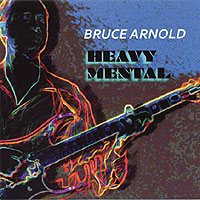 NYC
based musician Bruce Arnold has got to be one of the most well-rounded
guitarists currently recording in 2010. Following the passing of several
years, mwe3.com caught up with Bruce only to find that he’s recently
released no less than four quite different CDs in the past few years.
First off among his latest albums is Heavy Mental by
the Bruce Arnold Trio. Backed up by Andy Galore (bass)
and Kirk Driscoll (drums), this is Bruce like you’ve never
heard him. Who knew Bruce had such a hard hitting jazz-rock fusion
instrumental side to his muse? Bruce was always an avant gard purveyor
of the guitar—breaking down sonic walls with daredevil acumen—but
on Heavy Mental, the sound is more guitar-centric jazz-rock
fusion ala Terje Rypdal, Satch and Allan Holdsworth. The seven cut
all instrumental Heavy Mental CD is superbly recorded, while
in depth liner notes by noted jazz musicologist Bill Milkowski
fills in the blanks on this amazing fully formed fusion outing.
Nearly the same could be said about Arnold’s other 2010 release
entitled The Art Of The Blues. Backed by Dean
Johnson (bass) and Tony Moreno (drums), the twelve track
CD is once again all instrumental but this is no easy on the ears
blues based CD. With tracks written and recorded in time signatures
like 7/4 and 9/4, Arnold’s Art Of The Blues
NYC
based musician Bruce Arnold has got to be one of the most well-rounded
guitarists currently recording in 2010. Following the passing of several
years, mwe3.com caught up with Bruce only to find that he’s recently
released no less than four quite different CDs in the past few years.
First off among his latest albums is Heavy Mental by
the Bruce Arnold Trio. Backed up by Andy Galore (bass)
and Kirk Driscoll (drums), this is Bruce like you’ve never
heard him. Who knew Bruce had such a hard hitting jazz-rock fusion
instrumental side to his muse? Bruce was always an avant gard purveyor
of the guitar—breaking down sonic walls with daredevil acumen—but
on Heavy Mental, the sound is more guitar-centric jazz-rock
fusion ala Terje Rypdal, Satch and Allan Holdsworth. The seven cut
all instrumental Heavy Mental CD is superbly recorded, while
in depth liner notes by noted jazz musicologist Bill Milkowski
fills in the blanks on this amazing fully formed fusion outing.
Nearly the same could be said about Arnold’s other 2010 release
entitled The Art Of The Blues. Backed by Dean
Johnson (bass) and Tony Moreno (drums), the twelve track
CD is once again all instrumental but this is no easy on the ears
blues based CD. With tracks written and recorded in time signatures
like 7/4 and 9/4, Arnold’s Art Of The Blues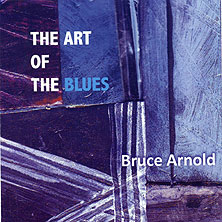 combines to create a collection of tracks that—while sounding
like a traditional jazz guitar set—actually presents a new approach
for Arnold and clearly is a refreshing redirection for the blues.
Fitting in perfectly with Arnold’s daring approach to the electric
guitar is Secret Code—written and recorded by Bruce
Arnold and guitarist Jane Getter. A true tour de force of electric
guitar extrapolations, the twelve track instrumental CD is at once
avant garde in scope yet it’s completely captivating. The all-instrumental
Secret Code combines a wealth of musical styles—from the
straight ahead jazz guitar duo sound to a more adventurous concept
taking in electronic flavors, distortion and wah-wah with synthetically
processed sounds and organic, mellower sounds. One of Bruce Arnold's
finest and most adventurous albums is his truly pioneering release
of Sonic Infestation—a pairing with the like minded
guitarist / percussionist John Stowell. A 2008 release, the
CD really takes you out there with free improv and abstract sound
collages that bring to mind ‘70s guitar pioneers like Fred Frith
for example. No sonic stuck in the mud himself, Fred would probably
dig Bruce overall, but I would think, especially Bruce’s release
with John Stowell. Acoustic guitars, electronics, off the wall percussion
and more collide on a CD that is truly inventive. Perhaps the thing
that holds each of these four albums together—besides the inventive
guitar work and inquisitive guitar based approach—is the high
quality studio sonics of these recordings, which when combined, offers
a state of the art glimpse into Bruce Arnold’s multifaceted and
complex musical mind. www.Muse-Eek.com
/ www.BruceArnold.com
combines to create a collection of tracks that—while sounding
like a traditional jazz guitar set—actually presents a new approach
for Arnold and clearly is a refreshing redirection for the blues.
Fitting in perfectly with Arnold’s daring approach to the electric
guitar is Secret Code—written and recorded by Bruce
Arnold and guitarist Jane Getter. A true tour de force of electric
guitar extrapolations, the twelve track instrumental CD is at once
avant garde in scope yet it’s completely captivating. The all-instrumental
Secret Code combines a wealth of musical styles—from the
straight ahead jazz guitar duo sound to a more adventurous concept
taking in electronic flavors, distortion and wah-wah with synthetically
processed sounds and organic, mellower sounds. One of Bruce Arnold's
finest and most adventurous albums is his truly pioneering release
of Sonic Infestation—a pairing with the like minded
guitarist / percussionist John Stowell. A 2008 release, the
CD really takes you out there with free improv and abstract sound
collages that bring to mind ‘70s guitar pioneers like Fred Frith
for example. No sonic stuck in the mud himself, Fred would probably
dig Bruce overall, but I would think, especially Bruce’s release
with John Stowell. Acoustic guitars, electronics, off the wall percussion
and more collide on a CD that is truly inventive. Perhaps the thing
that holds each of these four albums together—besides the inventive
guitar work and inquisitive guitar based approach—is the high
quality studio sonics of these recordings, which when combined, offers
a state of the art glimpse into Bruce Arnold’s multifaceted and
complex musical mind. www.Muse-Eek.com
/ www.BruceArnold.com
MWE3.COM
PRESENTS AN INTERVIEW WITH
BRUCE ARNOLD
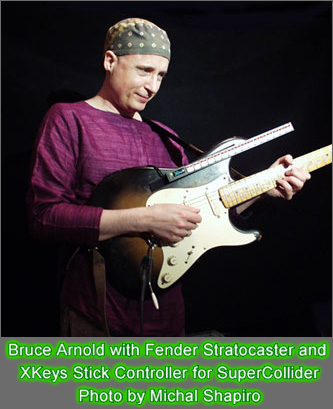 mwe3.com:
Can you say something about the events that led to the making of your
recently released Heavy Mental CD and how do you feel the album
reflects your interest in and performance of fusion guitar sounds?
mwe3.com:
Can you say something about the events that led to the making of your
recently released Heavy Mental CD and how do you feel the album
reflects your interest in and performance of fusion guitar sounds?
Bruce Arnold: I started out playing rock and mostly blues à
la Stevie Ray Vaughan sort of style way back in the ‘60s. I went
to Berklee in the late ‘70s and continued that sound via fusion
which was big at the time. When I moved to NYC, a good friend of mine,
Stuart Hamm would come to town playing with Joe Satriani and I loved
the sound Joe was getting because it was so expressive. Not having
that type of equipment at the time, I only dreamed about recreating
that sound.
Then a few years back I was doing a duet gig with Stanley Clarke.
I walked off stage and the representative for Peavey said that they
would like to send me some equipment. Well a few days later I had
the JSX (Joe Satriani) amp and three new Heavy Metal guitars! I was
like a kid in a candy store. Since then Music Man has sent me 4 of
their guitars so my current rig is the JSX and one of my four Music
Man Guitars. Awesome sound and great tone. I even have a Music Man
Double Neck which is the guitar for my follow-up CD to Heavy Mental.
You can get a taste of what's ahead for that on Youtube.com the composition
is called “Beauty Queen.” So now that I have the sound,
I'm quite excited about creating CDs with this new equipment in combination
with SuperCollider.
mwe3.com: Do you consider the Heavy Mental album to be jazz-rock
and what guitarists and eras of music would you say influenced you
most early on and then during the writing and recording process of
the new album?
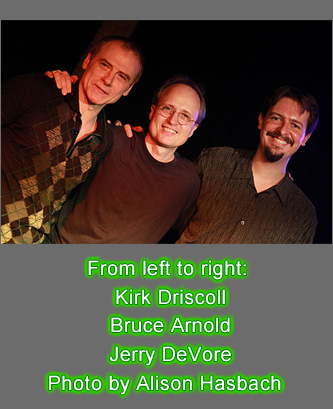 BA:
Well I guess some might call it jazz-rock because it has a sophistication
in the harmonies but really that sophistication is coming from 20th
century classical music, not jazz. Take for instance “12
Tone Boogie” or “Blues For Arnie” (Arnold Schoenberg).
The first part of the head is strictly 12 tone just like Webern or
Schoenberg would write. All the rest of the tunes are using hexatonic
scales divided into two trichords (3 note groups), this is again exactly
the kind of structures that the 2nd Viennese school would use (i.e.
Schoenberg, Berg and Webern.) I've just transferred this into a rock/heavy
metal sound and it works surprisingly well. So my main influence for
this music is really the application of these 12 tone principles into
the rock idiom. I should say that doing this is no easy feat and has
taken years of practice. So although when listening to the CD you
may think that I'm just playing a common blues line here and there,
in reality all solos on the CD are using hexatonic scales, not blues
scales. There are no overdubs for the guitar solos. These are all
live in the studio so in that sense it has the jazz influence of not
being a highly produced and overdubbed CD.
BA:
Well I guess some might call it jazz-rock because it has a sophistication
in the harmonies but really that sophistication is coming from 20th
century classical music, not jazz. Take for instance “12
Tone Boogie” or “Blues For Arnie” (Arnold Schoenberg).
The first part of the head is strictly 12 tone just like Webern or
Schoenberg would write. All the rest of the tunes are using hexatonic
scales divided into two trichords (3 note groups), this is again exactly
the kind of structures that the 2nd Viennese school would use (i.e.
Schoenberg, Berg and Webern.) I've just transferred this into a rock/heavy
metal sound and it works surprisingly well. So my main influence for
this music is really the application of these 12 tone principles into
the rock idiom. I should say that doing this is no easy feat and has
taken years of practice. So although when listening to the CD you
may think that I'm just playing a common blues line here and there,
in reality all solos on the CD are using hexatonic scales, not blues
scales. There are no overdubs for the guitar solos. These are all
live in the studio so in that sense it has the jazz influence of not
being a highly produced and overdubbed CD.
mwe3.com: How would you compare the sound and style of your guitar
playing and compositional approach on Heavy Mental with your
other new album Art Of The Blues and why did you choose to
use different musicians on both albums?
BA: Art Of The Blues is really the closest I've come to a traditional
jazz sound even though I was using a Fender Stratocaster on the date.
Both CDs are again using Pitch Class Set improvisation via hexatonic
scales. Art Of The Blues was a real challenge for me. I wanted
to write 12 keys of the blues using the hexatonic scale C, Db, Eb,
F#, G, A and have all chords and melodies derived from this structure.
Obviously it would change on every chord I, IV, V and in each key.
I also wanted to get away from playing 4 and 5 note chords so commonly
found in the jazz player repertoire, so you will find that most of
the comping is diads (two note structures) which is more like the
rhythm and blues style of chording on a blues tune. I also wanted
to add a rhythmic and phrasing element to the compositions. So you
will find the superimposition of 3 eighth notes time over the regular
time in many sections of these tunes and this kinds of structures
are reflected in the melodies. By placing the 3 eighth note rhythm
in the melody the drummer is able to move back and forth between two
different time levels freely throughout each piece. Tony Moreno does
a great job of this in a very musical way. I also wanted to get away
from the typical 4 bar phrasing found in jazz and blues so you will
find many compositions with 5 bar phrases or the use of 7/4, 5/4 and
_ time signatures.
The musicians were chosen because of their commitment to the project
and their great musicianship. I feel very lucky to live in NYC where
you have access to such world class musicians to help you express
your vision.
mwe3.com: How would you say your unique guitar sound combines your
love of experimental music with your blues, rock and fusion influences?
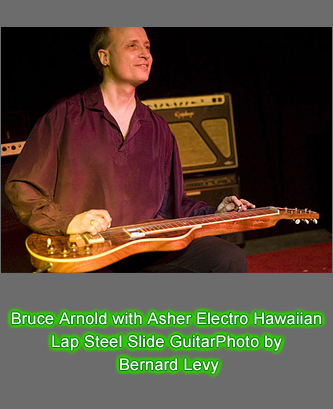 BA:
I think that all of these influences flow together to form my current
sound. I'm very restless and I'm always trying to push the envelope.
I want to continue to also push my use of SuperCollider (object oriented
music programming platform for the Mac). When I play I always play
through this program via a laptop and this also is a major part of
my sound. All reverbs, delays and special effects are created from
scratch using this program. I should also mention that Newton Armstrong
helped a lot in teaching me this program and helping with organization
and advanced programming knowledge. This program is amazing and allows
me to push the possibilities of the guitar to new places.
BA:
I think that all of these influences flow together to form my current
sound. I'm very restless and I'm always trying to push the envelope.
I want to continue to also push my use of SuperCollider (object oriented
music programming platform for the Mac). When I play I always play
through this program via a laptop and this also is a major part of
my sound. All reverbs, delays and special effects are created from
scratch using this program. I should also mention that Newton Armstrong
helped a lot in teaching me this program and helping with organization
and advanced programming knowledge. This program is amazing and allows
me to push the possibilities of the guitar to new places.
mwe3.com: What guitars are featured on the Heavy Mental and
the Art Of The Blues albums and are there any interesting developments
in the guitar / gear world lately that is lately catching your ears
and eyes?
BA: On Heavy Mental I used the Peavey JSX and the Peavey V-type
guitar and on "Blues for Arnie" I also used the Music Man
JP. Art Of The Blues uses a ‘69 Fender Bassman Amp (original)
and an ‘81 Fender Stratocaster reissue. In general, I'm not much
for boxes and other gear that only give you the sounds some programmer
at some company decided is cool. I want to have the ability to create
something new and personal on my own, and any equipment that allows
this is high on my list. That said, I should also mention that I used
a Klon Centaur distortion pedal on Heavy Mental and a FullTone
"Clyde" Wah Wah.
mwe3.com: What guitarists and eras of music most interest you and
do you listen much to other guitarists and composers these days and
if so, what artists and guitarists interest you in 2010?
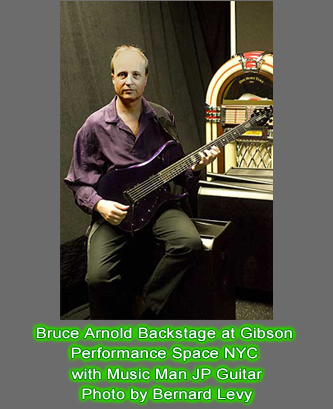 BA:
Actually lately I haven't listened too much to other guitarists. Since
I have my own recording studio here in Greenwich Village I'm always
working and listening to new projects and don’t have a lot of
time to check out other things. My latest projects incorporate the
sound of lap steel slide guitar. Rayco Resophonics and Asher gave
me endorsements and sent me some wonderful instruments. You can hear
me using the the Rayco
“Weissenborn” on YouTube and the Asher can be heard
at the end of Beauty
Queen also on YouTube. But in general with all the music I’m
doing I have a sound in my head and it is giving me all the inspiration
I need at the moment.
BA:
Actually lately I haven't listened too much to other guitarists. Since
I have my own recording studio here in Greenwich Village I'm always
working and listening to new projects and don’t have a lot of
time to check out other things. My latest projects incorporate the
sound of lap steel slide guitar. Rayco Resophonics and Asher gave
me endorsements and sent me some wonderful instruments. You can hear
me using the the Rayco
“Weissenborn” on YouTube and the Asher can be heard
at the end of Beauty
Queen also on YouTube. But in general with all the music I’m
doing I have a sound in my head and it is giving me all the inspiration
I need at the moment.
mwe3.com: When did you start the Muse-Eek music company and how much
of your time is devoted to recording your own music compared to say,
your publishing of books and time spent on the day to day of company
itself?
BA: Muse Eek Publishing really grew out of two things. I grew up in
South Dakota in the ‘50s and ‘60s when there was no internet
so accessing the right information to learn the guitar was very difficult.
I spent many years practicing the wrong things, and then having to
unlearn them and start over; it was painful in so many ways. I didn't
want to see that happen to others. I started writing books to help
a serious guitarist develop their skills, but in the back of my mind
it was also my way of helping them to avoid the bad start that I had
had. I started writing the books the same time I started teaching
at NYU. There was no curriculum for guitar when I started back in
the early ‘90s, so that spurred a series of books on sight reading,
ear training and basic information that all serious guitarists need
to know.
I usually spend about 1 to 2 hours a day either answering emails from
guitarists that need help understanding how to practice stuff from
my books or needing further guidance to decide on what books to work
with next. Muse-eek.com has created a new download section which has
really opened up a worldwide use of my books. Now students from anywhere
can download this information and don't have to spend a fortune in
shipping. It's always a balancing act to divide my time between books,
recording, teaching (NYU and Princeton) and performing.
As far as new books go I'm quite excited about the new edition of
1st Steps for Beginning Guitarist which is an .epub book available
for the ipad. This book has over 400 videos and audio files that can
be accessed directly through the ipad. You
can see an example of using this book on youtube.com I think this
new platform will revolutionize the learning of music. I'm also excited
about my Sonic Resource guide book which is really a reference book
showing you all 220 possible scales with all the 3 and 4 note chords
that can be derived from these scales as well as which chords these
scales will work over. It also gives you the possible hexatonic scales
that can be found where applicable. I teach a course with this book
at the NYU Summer Guitar Intensive which meets every July in NYC at
NYU and it can really open your eyes to a new way of thinking about
music and gives you tons of ideas for composition and improvisation.
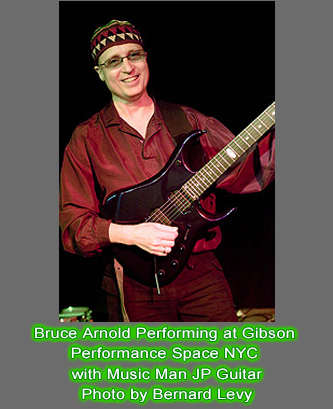 mwe3.com:
It’s interesting to note you’re originally from South Dakota.
How many years have you lived in NYC and how would you compare the
two places? What do you like most about NYC and do you consider yourself
a New Yorker now? (laughter)
mwe3.com:
It’s interesting to note you’re originally from South Dakota.
How many years have you lived in NYC and how would you compare the
two places? What do you like most about NYC and do you consider yourself
a New Yorker now? (laughter)
BA: Yes, I grew up in Sioux Falls, South Dakota. You would think it
was pretty devoid of good musicians but I was lucky to have Dave Wood
(guitar), Mike Miller (guitar) and Mark Craney (drums) among others
to get inspiration. I moved to Boston when I was about 23 and attended
Berklee College of Music. This was the heyday for guitar there, with
Mike Stern, Bill Frisell, Pat Metheny, Wayne Krantz, Steve Vai...I
could go on and on...all kicking around Berklee. It really made me
work hard to lift my musicianship to those levels. Of course I didn't
know that most of these people would be the next generation of great
guitarists. At the time I just thought that was the level of all guitarists.
I know better now...
I certainly feel I'm a New Yorker now that I've lived here for over
20 years. It's really a great city. So easy to get around, safe and
so many great artists to interact with. I also miss South Dakota and
it's open spaces and simple life but we are lucky to have an apartment
here in the Village with a beautiful garden that my girlfriend Michal
Shapiro tends to each year. Looking out my window as I practice each
day I could be anywhere it really doesn't feel like a big city.
mwe3.com: What plans do you have for 2011 and beyond? Any chance for
a box set or multi-disc anthology of your music?
BA: I just noticed the other day that Theorchard.com my distributor
allows you to make multi-disc MP3 sets so I'm thinking about that.
I just finished an anthology for my co-lead group Spooky Actions,
which is sort of my "cover band." We do covers of Webern,
Schoenberg, Messiaen to name a few. This highly challenging group
has six CDs and we chose a few of the strongest tracks to have on
a compilation called Spooky Actions: Retrospective.
2011 will have me writing new music for rock trio using the Music
Man double neck and new music for jazz trio. I would also like to
finish up a couple of recordings I have with Dave Schroeder on blues
harp and me on lap steel slide guitar as well as finish a duet CD
with John Gunther playing the Bartok Romanian Dances.
Thanks to Bruce Arnold @ www.Muse-Eek.com
/ www.BruceArnold.com



